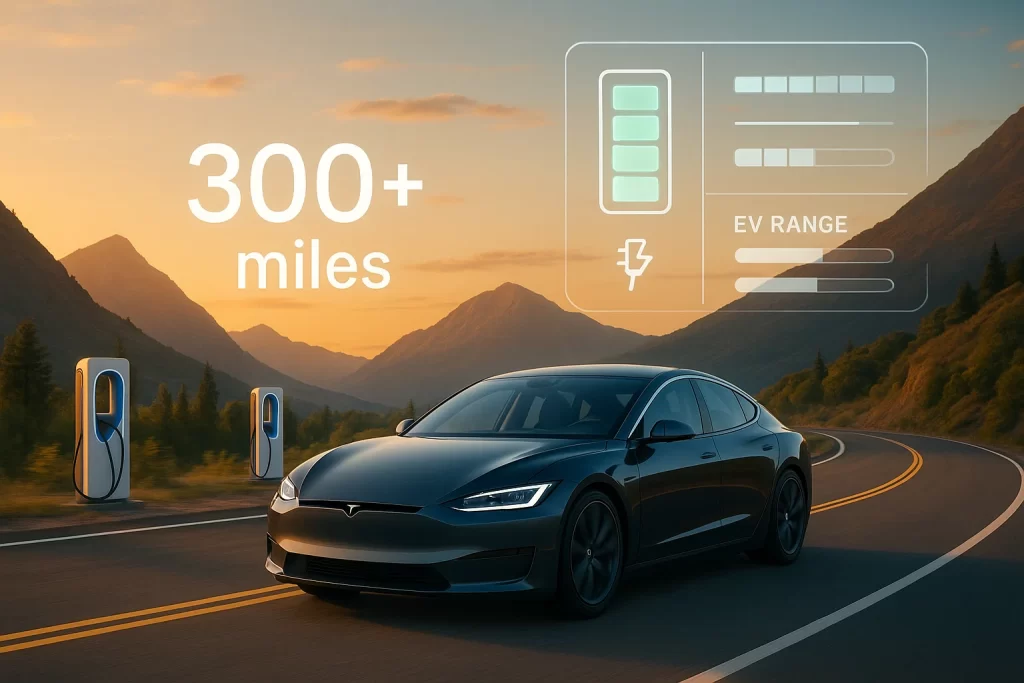Why Driving Range Has Become a Top Priority for EV Manufacturers
n the fast-evolving world of electric vehicles (EVs), one metric stands out above the rest: driving range. As EV adoption accelerates globally, automakers are doubling down on extending how far electric cars can travel on a single charge. It’s no longer just about sustainability—range anxiety is a real concern, and carmakers are racing to eliminate it.

Tesla Set the Standard for EV Range
When Tesla launched the Model S in the early 2010s, it didn’t just bring an electric car to market—it redefined what was possible. Offering a real-world range of over 200 miles right out of the gate, with extended-range options crossing the 300-mile mark, Tesla raised the bar and changed consumer expectations overnight.
This early focus on range wasn’t just a performance spec—it was a branding decision that worked. Tesla positioned itself as not only a pioneer but a practical solution for daily driving and long-distance travel, removing one of the biggest barriers to EV ownership.
Traditional Carmakers Playing Catch-Up
While legacy automakers like Ford, GM, and Toyota publicly acknowledged the shift toward electric mobility, many were slow to respond with serious innovation. Instead of proactively developing longer-range EVs, they seemed content with compliance-level models offering modest mileage, often under 150 miles per charge.
Now, with the global push toward electrification gaining momentum and consumers demanding more range, traditional brands are stepping up their game. Improved battery tech, more efficient drivetrains, and enhanced regenerative braking systems have enabled many newcomers to finally break the 250-mile range barrier.
Why Range is Critical for EV Buyers
For today’s car buyers, especially those transitioning from internal combustion engine (ICE) vehicles, range is a top concern. No one wants to be caught with a drained battery and nowhere to charge. As a result, manufacturers who highlight range in their marketing see better engagement and stronger sales. It’s no coincidence that the EVs with the longest range often rank highest in consumer satisfaction and resale value.
Real-World vs. Advertised Range
A key point for EV shoppers to understand is the difference between manufacturer-estimated range and real-world range. Official figures often reflect ideal lab conditions. Variables like weather, terrain, driving speed, and accessory use (e.g., air conditioning) can significantly affect actual mileage.
That’s why independent testers and consumer reports play an important role in verifying these claims. Vehicles like the Hyundai Kona Electric (259 miles), Jaguar I-Pace (253 miles), and Kia e-Niro (253 miles) have all undergone such third-party validation, confirming that real-world performance closely aligns with marketing claims.
Who Leads the Pack Today?
Here’s a snapshot of current top EV performers by range (verified in real-world testing):
| Model | Estimated Range (miles) | Battery Size (kWh) |
|---|---|---|
| Tesla Model S Long Range | 370+ | 100 |
| Hyundai Kona Electric | 259 | 64 |
| Jaguar I-Pace | 253 | 90 |
| Kia e-Niro | 253 | 64 |
| Polestar 2 | 245 | 78 |
Innovation Driving Competition
As battery technology continues to advance, the push for greater range is intensifying. Solid-state batteries, ultra-fast charging capabilities, and improved energy density are expected to push EV range even further—some concept vehicles claim future potential exceeding 500 miles per charge.
Carmakers now view long-range EVs as a necessity, not a luxury. This has sparked a technological arms race, benefiting consumers through better choices, increased affordability, and greater convenience.
Will Gasoline Still Compete?
The only potential speed bump? Oil prices. When fuel costs drop, traditional vehicles can appear more appealing in the short term. But long-term trends—including government emissions targets, climate legislation, and fuel taxation—strongly favor electric mobility. Even if combustion engine development lingers, the shift to electric is irreversible.
Future-Proof Your Lifestyle with a Home EV Charger
As EV ownership grows, so does the demand for home EV charging stations. A personal charging point not only increases convenience but can reduce running costs substantially—especially when combined with off-peak energy tariffs or solar power systems.
Government incentives in many countries, including the UK’s OZEV grant, make this an ideal time to install a home charger. With more EV models offering over 250 miles per charge, home charging infrastructure will become as common as Wi-Fi routers in the near future.
Frequently Asked Questions (FAQs)
1. Why is range so important in EVs?
Range determines how far an electric vehicle can travel without recharging. It directly impacts driver confidence and convenience, especially in regions with fewer public charging stations.
2. Are manufacturer-claimed EV ranges accurate?
They are good estimates, but real-world range can vary based on driving habits, terrain, climate, and usage of features like air conditioning.
3. Does a longer range make an EV more expensive?
Generally, yes—larger batteries cost more. However, the added convenience and long-term fuel savings often justify the higher upfront price.
Final Thoughts
EV range isn’t just a buzzword—it’s the battleground on which automakers are fighting for market dominance. Tesla may have fired the starting gun, but now the entire automotive industry is racing to meet (or exceed) those expectations.
With more high-range electric cars entering the market each year, and home EV charging stations becoming increasingly affordable, there’s never been a better time to switch to electric. Whether you’re a city commuter or a cross-country explorer, there’s an EV—and a range—for you.

